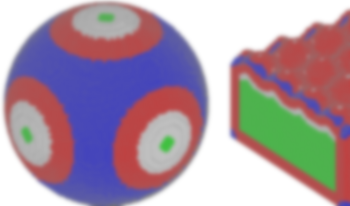
Two-and-a-half and 3D printing are becoming increasingly popular, and consequently the demand for high quality surface reproduction is also increasing. Halftoning plays an important role in the quality of the surface reproduction. Three dimensional halftoning methods, that adapt the halftone structures to the geometrical structure of 3D surfaces or to the viewing direction, could further improve surface reproduction quality. In this paper, a 3D adaptive halftoning method is proposed, that incorporates different halftone structures on the same 3D surface. The halftone structures are firstly adapted to the 3D geometrical structure of the surface. Secondly, the halftone structures are adapted based on the normal vector to the surface at a specific voxel. Two simple approaches to approximate the normal vector are also proposed. The problem of edge artefacts that might occur in the previously proposed 3D Iterative Method Controlling the Dot Placement (IMCDP) halftoning method is discussed and a solution to reduce these artefacts is given. The results show that the proposed adaptive halftoning can combine different halftone structures on the same 3D surface with no transition artefacts between different halftone structures. It is also shown that using second-order frequency modulation (FM) halftone, in comparison to first-order FM, can result in more homogeneous appearance of 3D surfaces with undesirable structures on them.
Sasan Gooran, Fereshteh Abedini, "Three-Dimensional Adaptive Digital Halftoning" in Journal of Imaging Science and Technology, 2022, pp 060403-1 - 060403-12, https://doi.org/10.2352/J.ImagingSci.Technol.2022.66.6.060403
 Find this author on Google Scholar
Find this author on Google Scholar Find this author on PubMed
Find this author on PubMed

